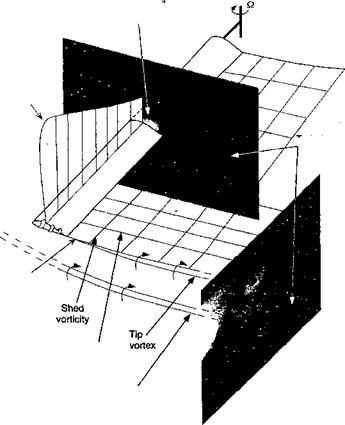Concepts of the Blade Wake
The wake from the rotating blade comprises, in part, a vortical shear layer or vortex sheet, with a concentrated vortex formed at the blade tip. The vortex sheet is comprised of vorticity with vectors aligned mainly normal to and parallel to the trailing edge of the
|
![]()
![]()

 |
|
Flapping
Flowfield structure
![]()
![]()
 |
 |
 |
Aperiodic

 Pitch (from blade controls & torsional response)
Pitch (from blade controls & torsional response)
Plunge or heave (from blade flapping)
Time-varying incident velocity or lead-lagging biaae or horizontal gusts
![]()
|
|
|
|
|
|
|
|
|
|
|
|
|
|

blade, as shown in Fig. 8.3, which is a schematic reconstruction of the wake behind a rotor blade using both flow field measurements and flow visualization. The strength of the former component (the trailed vorticity) is related to the spanwise gradient of lift (circulation, Г) on the blade (i. e., to 3Г/3r), whereas the latter component (the shed vorticity) is related to the time rate of change of lift on the blade (i. e., to ЭГ/dt). Experiments with rotors have shown that the blade tip vortices are almost fully rolled-up within only a few degrees of blade rotation. Because the aerodynamic loading on the blades is biased toward their tips, the tip vortex is of high overall strength with significant induced velocities.
While the fundamental process of the blade wake and tip vortex formation is similar to that found with a fixed wing, one obvious difference with helicopter tip vortices is that they are curved and so they experience a self-induced effect. Another complication with helicopter rotors is that the wakes and tip vortices from other blades can lie close to each other and to the plane of blade rotation and so have large induced effects on the blade lift distribution. Because of these self – and mutually induced effects, the problem of calculating the detailed airloads over the rotor disk is quite formidable. Miller (1964) has examined the higher harmonics of the rotor loading in forward flight and has concluded that the effects of the trailed wake (tip vortices) are generally more important than the shed wake; only for very low advance ratios or for hove^ do the effects of the “returning” shed wake or the shed
wake from other blades seem to be important. However, the effects of the “near” shed wake (that is, the wake vorticity immediately behind each blade) on the blade from which it was generated were found to be important under all flight regimes. These observations suggest that the overall aerodynamic environment at the blade (specifically, the quasi-steady angle of attack at the blade element) is determined mainly by the trailed wake (tip vortex) system. In general, unsteady aerodynamic effects are relatively local and are a consequence of the time history of the vorticity contained in the shed wake immediately behind each blade. Such observations often permit simplified forms of mathematical analysis to be pursued, without substantial loss of accuracy in predicting the unsteady airloads on the rotor.












